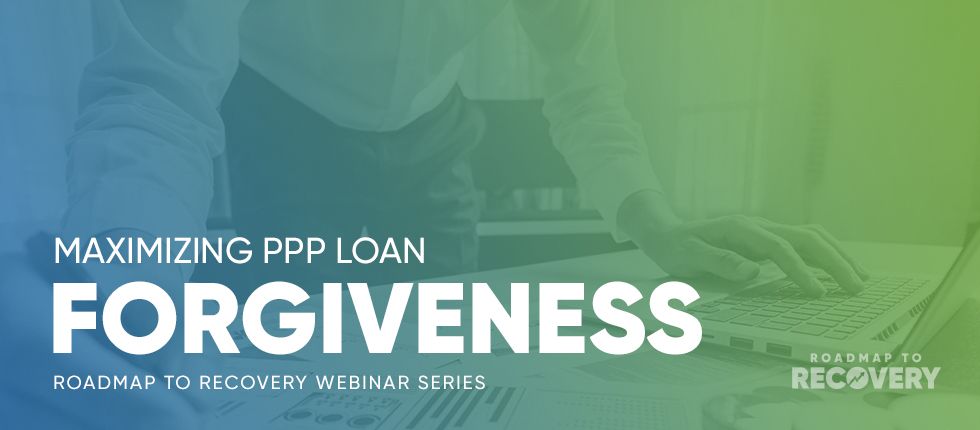Roadmap to Recovery: Maximizing PPP Loan Forgiveness
The next step on your business’ roadmap to recovery is maximizing your Paycheck Protection Program loan forgiveness. These loans give business owners the power to maintain their company and keep their employees on the payroll, without worrying about paying the disbursement back in full.
Paycheck Protection Program
As part of the CARES Act approved by Congress on March 26, the government enacted the Paycheck Protection Program (PPP). The program consists of loans worth 2.5x a company’s monthly payroll, up to $10 million. Loans from the PPP offer 1% interest for a term of 2 years.
Loans from the Paycheck Protection Program are also forgivable so long as you use the disbursement to keep all your employees on your payroll and use the remaining funds for eligible allocations. The SBA and the federal government have determined what constitutes an eligible allocation.
Approved Loan Uses and Stipulations
The loan disbursement from the PPP can be used for payroll costs, employee benefits, mortgage interest payments, rent payments, utilities and interest on other debt accrued prior to February 15, 2020.
While the government has approved several uses for the PPP disbursement, in order to qualify for forgiveness, at least 75% of it must be used for payroll costs. The other 25% of the loan can be used for the other qualified expenses.
Eligible payroll costs include:
- Employee compensation, up to $100,000 per employee
- Payment for vacation time
- Payment for parental, family, medical or sick leave
- Allowance for dismissal or separation
- Group healthcare benefits, including insurance premiums
- Retirement benefits
- Taxes assessed on employee compensation
There are also a few expenses that do not count toward the 75% payroll allotment. Including payments made to 1099 contractors or non-U.S. residents.
Maximizing PPP Loan Forgiveness
In order to maximize forgiveness, your business will need to diligently maintain documentation to take back to your lender after the loan period is up. You’ll most likely need to provide your lender with:
- Employment and Wage Documentation
This is a record showing the number of employees you maintained on your payroll and their wage levels. You will also need to provide documentation of any paid leave, provided benefits and tax levied on compensation.
- Receipts and Invoices
Maintain copies of receipts and invoices verifying payments on things like interest payments on mortgage dues or debt. So this includes copies of utility payments, like electricity, gas, water, transportation, telephone and internet access, etc.
- Official Certification
A representative from your organization will need to provide certification that they can verify that any provided documentation is true and complete in accordance with Paycheck Protection Program guidelines.
The government has allowed for partial forgiveness on these loans as well. Proportion of loan forgiveness will decline as headcount of employees declines or as salaries decrease. Employers who have laid off or furloughed employees or employers who have decreased employee salaries have until June 30, 2020 to reinstate the employees to their previous employment status and salary level. The amount of forgiveness the employer is eligible for increases proportionate to the number of employees reinstated.
Tracking Strategies
Tracking the way your business allocates your Paycheck Protection Program disbursement is vital to maximizing the forgiveness of your loan. If your business was also approved for an SBA funded Economic Injury Disaster Loan (EIDL), you must allocate the funding to different expenses. Using the following tracking strategies will help you understand how to apply the funding to your business in the best way possible.
Track other Approved Expenses
Maintain two separate spreadsheets for tracking Paycheck Protection Program allocations. For one spreadsheet, multiply the amount of your loan disbursement by 0.25. This determines how much of your loan can be used for approved non-payroll expenses.
In the second spreadsheet, keep track of the remaining 75% of the loan disbursement for payroll and employee benefit expenses. So as you use the funding for approved expenses, separate the deductions by approved category. Maintain receipts, invoices and records of each of the recorded payments in a single, easy-to-access digital file.
Add Supporting Documentation
In addition to your well-organized spreadsheet, maintain additional documentation that validates the expenses you are recording. These documents include:
- IRS payroll tax filings
- Mortgage/rent agreements
- Utility accounts in the business’ name
- Previous tax returns
Additional records lend extra credibility to the documentation you will take to your lender when you apply for complete loan forgiveness. When maintaining your records for your PPP disbursement, err on the side of too many supporting documents, rather than too few.
Build a Cashflow Forecast
A cashflow forecast is a 13-week financial model that shows where your available cash will be going. The forecast should be updated weekly to ensure that each of your financial decisions is backed financially. The forecast will help you determine how best to distribute your disbursement, whether it’s payroll or utility payments. As you determine how to allocate your funding, your cashflow forecast will also help you decide whether to seek other outside funding, like an Economic Injury Disaster Loan distributed by the SBA. Understanding where your funding is going is vital to making sure you use it wisely and in a way that maximizes your forgiveness.



